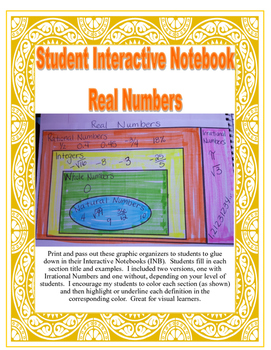Vagnozzi's Variables
16 Followers
Resource Type
Standards
CCSS6.NS.C.6
CCSS8.NS.A.1
CCSS8.NS.A.2
CCSSHSN-RN.A.1
CCSSHSN-RN.A.2
Formats Included
- PDF
Pages
3 pages
Vagnozzi's Variables
16 Followers
Description
A graphic organizer for students to glue down in their interactive student notebooks (INB). Students fill in each section title and examples. I included two versions, one with Irrational Numbers and one without, depending on your level of students. I encourage my students to color each section (as shown) and then highlight or underline each definition in the corresponding color. Great for visual learners.
Total Pages
3 pages
Answer Key
Does not apply
Teaching Duration
30 minutes
Last updated Jul 11th, 2016
Report this resource to TPT
Reported resources will be reviewed by our team. Report this resource to let us know if this resource violates TPT’s content guidelines.
Standards
to see state-specific standards (only available in the US).
CCSS6.NS.C.6
Understand a rational number as a point on the number line. Extend number line diagrams and coordinate axes familiar from previous grades to represent points on the line and in the plane with negative number coordinates.
CCSS8.NS.A.1
Know that numbers that are not rational are called irrational. Understand informally that every number has a decimal expansion; for rational numbers show that the decimal expansion repeats eventually, and convert a decimal expansion which repeats eventually into a rational number.
CCSS8.NS.A.2
Use rational approximations of irrational numbers to compare the size of irrational numbers, locate them approximately on a number line diagram, and estimate the value of expressions (e.g., π²). For example, by truncating the decimal expansion of √2, show that √2 is between 1 and 2, then between 1.4 and 1.5, and explain how to continue on to get better approximations.
CCSSHSN-RN.A.1
Explain how the definition of the meaning of rational exponents follows from extending the properties of integer exponents to those values, allowing for a notation for radicals in terms of rational exponents. For example, we define 5 to the 1/3 power to be the cube root of 5 because we want (5 to the 1/3 power)³ = 5 to the (1/3)(3) power to hold, so (5 to the 1/3 power)³ must equal 5.
CCSSHSN-RN.A.2
Rewrite expressions involving radicals and rational exponents using the properties of exponents.




